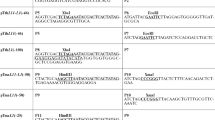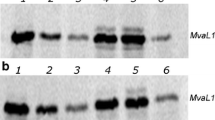Summary
The trmD operon of Escherichia coli consists of the genes for the ribosomal protein (r-protein) S16, a 21 kDa protein (21K) of unknown function, the tRNA(m1G37)methyltransferase (TrmD), and r-protein L19, in this order. Previously we have shown that the steady-state amount of the two r-proteins exceeds that of the 21K and TrmD proteins 12- and 40-fold, respectively, and that this differential expression is solely explained by translational regulation. Here we have constructed translational gene fusions of the trmD operon and lacZ. The expression of a lacZ fusion containing the first 18 codons of the 21K protein gene is 15-fold higher than the expression of fusions containing 49 or 72 codons of the gene. This suggests that sequences between the 18th and the 49th codon may act as a negative element controlling the expression of the 21K protein gene. Evidence is presented which demonstrates that this regulation is achieved by reducing the efficiency of translation.
Similar content being viewed by others
References
Baker HV II, Wolf RE Jr (1984) Essential site for growth rate-dependent regulation within the Escherichia coli gnd structural gene. Proc Natl Acad Sci USA 81:7669–7673
Barcak GJ, Wolf RE Jr (1988) Comparative nucleotide sequence analysis of growth-rate-regulated gnd alleles from natural isolates of Escherichia coli and from Salmonella typhimurium LT-2. J Bacteriol 170:372–379
Bergmann JE, Lodish HF (1979) A kinetic model of protein synthesis. Application to hemoglobin synthesis and translational control. J Biol Chem 254:11927–11937
Bertani G (1951) Studies on lysogenesis. I. The mode of phage liberation by lysogenic Escherichia coli. J Bacteriol 62:293–300
Bingham AHA, Busby SJW (1987) Translation of galE and coordination of galactose operon expression in Escherichia coli: effects of insertions and deletions in the non-translated leader sequence. Mol Microbiol 1:117–124
Bonekamp F, Andersen HD, Christensen T, Jensen KF (1985) Codon-defined ribosomal pausing in Escherichia coli detected by using the pyrE attenuator to probe the coupling between transcription and translation. Nucleic Acids Res 13:4113–4123
Byström AS, Björk GR (1982) The structural gene trmD for the tRNA(m1G)-methyltransferase is part of a four polypeptide operon in Escherichia coli K-12. Mol Gen Genet 188:447–454
Byström AS, Fink GR (1984) A functional analysis of the repeated methionine initiator tRNA genes (IMT) in yeast. Mol Gen Genet 216:276–286
Byström AS, Hjalmarsson KJ, Wikström PM, Björk GR (1983) The nucleotide sequence of an Escherichia coli operon containing genes for the tRNA-(m1G)methyltransferase, the ribosomal proteins S16 and L19 and a 21-K polypeptide. EMBO J 2:899–905
Byström AS, von Gabain A, Björk GR (1989) Differentially expressed trmD ribosomal protein operon of Escherichia coli is transcribed as a polycistronic mRNA species. J Mol Biol 208:575–586
Carter PW, Bartkus JM, Calvo JM (1986) Transcription attenuation in Salmonella typhimurium: the significance of rare leucine codons in the leu leader. Proc Natl Acad Sci USA 83:8127–8131
Casadaban MJ, Cohen SN (1980) Analysis of gene control signals by DNA fusion and cloning in Escherichia coli. J Mol Biol 138:179–207
Casadaban MJ, Chou J, Cohen SN (1980) In vitro gene fusions that join an enzymatically active β-galactosidase segment to amino-terminal fragments of exogenous proteins: Escherichia coli plasmid vectors for the detection and cloning of translational initiation signals. J Bacteriol 143:971–980
de Boer HA, Kastelein RA (1986) Biased codon usage: an exploration of its role in optimization of translation. In: Reznikoff W, Gold L (eds) Maximizing gene expression. Butterworth, Stoneham, MA, p 225
Dreyfus M (1988) What constitutes the signal for the initiation of protein synthesis on Escherichia coli mRNAs? J Mol Biol 204:79–94
Dreyfus M, Kotlarz D, Busby S (1985) Point mutations that affect translation initiation in the Escherichia coli galE gene. J Mol Biol 182:411–417
Dunn JJ, Buzash-Pollert E, Studier FW (1978) Mutations of bacteriophage T7 that affect initiation of synthesis of the gene 0.3 protein. Proc Natl Acad Sci USA 75:2741–2745
Eriksson U, Sundelin J, Rask L, Peterson PA (1981) The NH2-terminal amino acid sequence of cellular retinoic-acid binding protein from rat testis. FEBS Lett 135:70–72
Fiers W, Contreras R, Duerinck F, Haegmean G, Merregaert J, Min Jon W, Van de Kerckhove J, Nolf F, Van Montagu M (1975) A-protein gene of bacteriophage MS2. Nature 256:273–278
Geisen RM, Fatscher H-P, Fuchs E (1987) More than 150-nucleotides flanking the initiation codon contribute to the efficiency of the ribosomal binding site from bacteriophage T7 gene 1. Nucleic Acids Res 15:4931–4943
Gold L, Stormo G (1987) Translational initiation. In: Neidhardt FC, Ingraham JL, Low KB, Magasanik B, Schaechter M, Umbarger HE (eds) Escherichia coli and Salmonella typhimurium. Cellular and Molecular Biology. American Society for Microbiology, Washington, DC, p 1302
Grosjean H, Fiers W (1982) Preferential codon usage in prokaryotic genes: the optimal codon-anticodon interaction energy and the selective codon usage in efficiently expressed genes. Gene 18:199–209
Harms E, Umbarger HE (1987) Role of codon choice in the leader region of the ilvGMEDA operon of Serratia marcescens. J Bacteriol 169:5668–5677
Heijne G von (1983) Patterns of amino acids near signal-sequence cleavage sites. Eur J Biochem 133:17–21
Holm L (1986) Codon usage and gene expression. Nucleic Acids Res 14:3075–3087
Hui A, Hayflick J, Dinkelspiel K, de Boer HA (1984) Mutagenesis of the three bases preceding the start codon of the β-galactosidase mRNA and its effect on translation in Escherichia coli. EMBO J 3:623–629
Ikemura T (1981) Correlation between the abundance of Escherichia coli transfer RNAs and the occurrence of the respective codons in its protein genes. J Mol Biol 146:1–21
Kozak M, Nathans D (1972) Translation of the genome of a ribonucleic acid bacteriophage. Bacteriol Rev 36:109–134
Laemmli UK, Favre M, (1973) Maturation of the head of bacteriophage T4: 1. DNA packaging events. J Mol Biol 80:575–599
Liljenström H, von Heijne G (1987) Translation rate modification by preferential codon usage: intragenic position effects. J Theor Biol 124:43–55
Looman AC, Bodlaender J, Comstock LJ, Eaton D, Jhurani P, de Boer HA, van Knippenberg PH (1987) Influence of the codon following the AUG initiation codon on the expression of a modified lacZ gene in Escherichia coli. EMBO J 6:2489–2492
Maniatis T, Fritsch EF, Sambrook J (1982) Molecular cloning: A laboratory manual. Cold Spring Harbor Laboratory, Cold Spring Harbor, New York
Manley JL (1978) Synthesis and degradation of termination and premature-termination fragments of β-galactosidase in vitro and in vivo. J Mol Biol 125:407–432
Matteucci MD, Heyneker HL (1983) Targeted random mutagenesis: the use of ambiguously synthesized oligonucleotides to mutagenize sequences immediately 5′ of an ATG initiation codon. Nucleic Acids Res 11:3113–3121
Miller JH (1972) Assay of β-galactosidase. In: Experiments in molecular genetics. Cold Spring Harbor Laboratory, Cold Spring Harbor, New York, p 352
Murray NE (1983) Phage lambda and molecular cloning. In: Hendrix RW, Roberts JW, Stahl FW, Weisberg RA (eds) Cold Spring Harbor Laboratory, Cold Spring Harbor, New York, p 395
Neidhardt FC, Bloch PL, Pedersen S, Reeh S (1977) Chemical measurement of steady-state levels of ten aminoacyl-transfer ribonucleic acid synthetases in Escherichia coli. J Bacteriol 129:378–387
Pedersen S (1984) Escherichia coli ribosomes translate in vivo with variable rate. EMBO J 3:2895–2898
Petersen C (1987) The functional stability of the lacZ transcript is sensitive towards sequence alterations immediately downstream of the ribosome binding site. Mol Gen Genet 209:179–187
Robertson HD, Lodish HF (1970) Messenger characteristics of nascent bacteriophage RNA. Proc Natl Acad Sci USA 67:710–716
Sanger F, Nicklen S, Coulson AR (1977) DNA sequencing with chain-terminating inhibitors. Proc Natl Acad Sci USA 74:5463–5467
Sanger F, Coulson AR, Barrell BG, Smith AJH, Roe BA (1980) Cloning in single-stranded bacteriophage as an aid to rapid DNA sequencing. J Mol Biol 143:161–178
Scherrer K, Darnell JE (1962) Sedimentation characteristics of rapidly labelled RNA from HeLa cells. Biochem Biophys Res Commun 7:486–490
Stormo GD (1986) Translation initiation. In: Reznikoff W, Gold L (eds) Maximizing gene expression. Butterworth, Stoneham, p 195
Stormo GD, Schneider TD, Gold LM (1982) Characterization of translational initiation sites in E. coli. Nucleic Acids Res 10:2971–2996
Tinoco I Jr, Borer PN, Dengler B, Levine MD, Uhlenbeck OC, Crothers DM, Gralla J (1973) Improved estimation of secondary structure in ribonucleic acids. Nature New Biol 246:40–41
Trädgårdh L, Curman B, Wiman K, Rask L, Peterson PA (1979) Chemical, physical-chemical, and immunologial properties of papain-solubilized human transplantation antigens. Biochemistry 18:2218–2225
Ullman A (1984) One-step purification of hybrid proteins which have β-galactosidase activity. Gene 29:27–31
Varenne S, Buc J, Lloubes R, Lazdunski C (1984) Translation is a non-uniform process. Effect of RNA availability on the rate of elongation of nascent polypeptide chains. J Mol Biol 180:549–576
Vogel HJ, Bonner DM (1956) Acetylornithinase of Escherichia coli: partial purification and some properties. J Biol Chem 218:97–106
Weissmann C, Billeter MA, Goodman HM, Hindley J, Weber H (1973) Structure and function of phage RNA. Annu Rev Biochem 42:303–328
Wikström PM, Björk GR (1988) Noncoordinate translation-level regulation of ribosomal and nonribosomal protein genes in the Escherichia coli trmD operon. J Bacteriol 170:3025–3031
Wikström PM, Byström AS, Björk GR (1988) Non-autogenous control of ribosomal protein synthesis from the trmD operon in Escherichia coli. J Mol Biol 203:141–152
Wolf RE Jr (1985) Growth-rate-dependent regulation of a central metabolism gene. In: Schaechter M, Neidhardt FC, Ingraham JL, Kjeldgaard NO (eds) The molecular biology of bacterial growth. Jones and Bartlett, Boston, p 202
Author information
Authors and Affiliations
Additional information
Communicated by H. Hennecke
Rights and permissions
About this article
Cite this article
Mikael Wikström, P., Björk, G.R. A regulatory element within a gene of a ribosomal protein operon of Escherichia coli negatively controls expression by decreasing the translational efficiency. Mol Gen Genet 219, 381–389 (1989). https://doi.org/10.1007/BF00259610
Received:
Issue Date:
DOI: https://doi.org/10.1007/BF00259610




